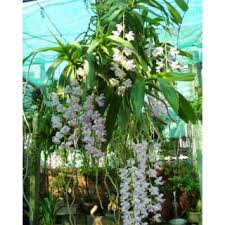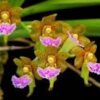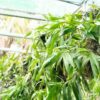# Exploring Pests and Diseases Affecting Quế Lan Hương (Dendrobium anosmum)

Quế Lan Hương, commonly known as Dendrobium anosmum, is a captivating orchid native to Southeast Asia, renowned for its delightful fragrance and stunning blooms. While these orchids are prized by collectors and enthusiasts alike, they are not immune to a range of pests and diseases that can threaten their health and vibrancy. Understanding these threats is crucial for maintaining the beauty and longevity of Quế Lan Hương. In this comprehensive guide, we will explore the most common pests and diseases that affect this species, their identification, prevention methods, and treatment options.
## 1. Understanding Quế Lan Hương
### 1.1 Overview
Quế Lan Hương, belonging to the Dendrobium genus, is a popular choice among orchid enthusiasts due to its striking flowers that bloom in various colors, including white, pink, and lavender. The plant thrives in warm, humid environments and requires specific care to flourish. Despite its hardiness, it can fall victim to pests and diseases, making knowledge of these threats essential for successful cultivation.
### 1.2 Growth Conditions
To ensure the healthy growth of Quế Lan Hương, it is crucial to replicate its natural environment. This orchid prefers bright, indirect light, a temperature range of 70°F to 85°F (21°C to 29°C), and high humidity levels. Proper watering, fertilization, and repotting practices are also essential for maintaining its health.
## 2. Common Pests Affecting Quế Lan Hương
### 2.1 Aphids
#### Identification
Aphids are small, soft-bodied insects that come in various colors, including green, black, and yellow. They typically cluster on new growth, stems, and flower buds.
#### Impact
Aphids feed on the sap of the plant, leading to stunted growth, yellowing leaves, and deformed flowers. They also excrete a sticky substance known as honeydew, which can attract sooty mold.
#### Prevention and Treatment
– **Prevention**: Regularly inspect your orchids for signs of aphids, particularly during the growing season.
– **Treatment**: Remove aphids with a strong stream of water or use insecticidal soap or neem oil for effective control.
### 2.2 Mealybugs
#### Identification
Mealybugs are small, white, cotton-like insects that often hide in the leaf axils and on stems. They can be easily recognized by their white, waxy coating.
#### Impact
Like aphids, mealybugs feed on the sap, causing leaf yellowing, wilting, and overall plant decline. They can also lead to secondary fungal infections due to their honeydew excretion.
#### Prevention and Treatment
– **Prevention**: Keep the growing area clean and free of debris that could harbor mealybugs.
– **Treatment**: Hand-pick mealybugs or use a cotton swab dipped in alcohol to remove them. For severe infestations, apply insecticidal soap or neem oil.
### 2.3 Spider Mites
#### Identification
Spider mites are tiny arachnids that are often difficult to see without a magnifying glass. They may appear as small specks on leaves and often leave fine webbing.
#### Impact
These pests suck the chlorophyll from leaves, causing a stippled appearance. Infestations can lead to leaf drop and reduced vigor in the plant.
#### Prevention and Treatment
– **Prevention**: Maintain high humidity and avoid excessive heat, as spider mites thrive in dry conditions.
– **Treatment**: Increase humidity around the plant and use insecticidal soap or miticides to control severe infestations.
### 2.4 Scale Insects
#### Identification
Scale insects appear as small, round, or oval bumps on stems and leaves. They can be hard or soft and may vary in color from brown to yellow.
#### Impact
Scales feed on plant sap, leading to weakened plants and potential leaf drop. Severe infestations can cause stunted growth and even death.
#### Prevention and Treatment
– **Prevention**: Regularly inspect plants and remove any scales by wiping leaves with a damp cloth.
– **Treatment**: Use horticultural oils or insecticidal soaps to smother scale insects. For heavy infestations, systemic insecticides may be necessary.
### 2.5 Thrips
#### Identification
Thrips are tiny, slender insects that are often yellow or black. They are difficult to see due to their small size and can be found on flowers and new growth.
#### Impact
Thrips feed on flower buds and young leaves, leading to scarring and distortion. They can also transmit viral diseases among orchids.
#### Prevention and Treatment
– **Prevention**: Keep the growing area clean and avoid overcrowding plants.
– **Treatment**: Use sticky traps to monitor thrip populations and apply insecticidal soap or neem oil for control.
## 3. Common Diseases Affecting Quế Lan Hương
### 3.1 Root Rot
#### Identification
Root rot is often caused by overwatering or poor drainage, leading to blackened, mushy roots and a foul odor.
#### Impact
Affected plants show signs of wilting and yellowing leaves due to inadequate water uptake. If not addressed, root rot can lead to plant death.
#### Prevention and Treatment
– **Prevention**: Ensure pots have adequate drainage and use well-aerated potting media.
– **Treatment**: Remove affected roots and repot the orchid in fresh, dry media. Adjust watering practices to prevent recurrence.
### 3.2 Leaf Spot
#### Identification
Leaf spot diseases manifest as dark, water-soaked lesions on leaves, which may expand over time.
#### Impact
Leaf spots can weaken the plant and, if severe, lead to leaf drop and overall decline.
#### Prevention and Treatment
– **Prevention**: Avoid overhead watering to minimize leaf wetness.
– **Treatment**: Remove affected leaves and apply fungicides if necessary. Improve air circulation around the plant to reduce humidity.
### 3.3 Powdery Mildew
#### Identification
Powdery mildew appears as a white, powdery coating on leaves and stems, often occurring in warm, dry conditions.
#### Impact
This fungal disease can weaken the plant and cause leaf distortion and drop if not controlled.
#### Prevention and Treatment
– **Prevention**: Ensure proper air circulation and avoid overcrowding plants.
– **Treatment**: Use fungicides specifically designed for powdery mildew, and improve air circulation around the plant.
### 3.4 Bacterial Soft Rot
#### Identification
Bacterial soft rot is characterized by water-soaked, mushy areas on leaves and stems, often accompanied by a foul odor.
#### Impact
This disease can quickly lead to the death of the affected plant if not treated promptly.
#### Prevention and Treatment
– **Prevention**: Avoid excessive moisture and ensure good drainage.
– **Treatment**: Remove affected plant parts and treat with a copper-based bactericide. Ensure plants are not overcrowded and improve ventilation.
### 3.5 Virus Diseases
#### Identification
Virus infections can cause a variety of symptoms, including leaf mottling, yellowing, and distortion. These symptoms can vary widely depending on the specific virus.
#### Impact
Viral infections can significantly reduce plant vigor and bloom quality, and affected plants should be discarded to prevent spreading.
#### Prevention and Treatment
– **Prevention**: Purchase healthy plants from reputable sources and avoid introducing potentially infected materials.
– **Treatment**: There is no cure for viral infections in orchids. The best approach is to remove and destroy affected plants to protect healthy specimens.
## 4. Best Practices for Orchid Care
### 4.1 Regular Inspection
Regularly inspecting your Quế Lan Hương for signs of pests and diseases is essential for early detection. Look for discolored leaves, abnormal growth, or any visible pests.
### 4.2 Proper Watering Techniques
Watering is one of the most critical aspects of orchid care. Ensure that you do not overwater, as this can lead to root rot and other moisture-related issues. Allow the potting medium to dry slightly between waterings.
### 4.3 Optimal Light Conditions
Providing the right amount of light is crucial for the health of Quế Lan Hương. Ensure that your orchids receive bright, indirect light to promote healthy growth and flowering.
### 4.4 Adequate Humidity and Air Circulation
Maintaining high humidity levels and good air circulation around your orchids can help prevent many pest and disease issues. Consider using humidity trays or misting the plants regularly.
### 4.5 Use of Quality Potting Media
Select a well-draining potting medium specifically designed for orchids. This will help prevent moisture retention and reduce the risk of root rot.
### 4.6 Fertilization
Regular fertilization during the growing season can boost the health of your orchids. Use a balanced orchid fertilizer, following the recommended dosage and schedule.
## 5. Conclusion
Quế Lan Hương is a beautiful and rewarding orchid to cultivate, but it is essential to be aware of the pests and diseases that can threaten its health. By understanding how to identify these issues and implementing preventative measures, orchid enthusiasts can enjoy vibrant, thriving plants.
Regular inspection, proper care, and prompt treatment are crucial for maintaining the beauty and longevity of Quế Lan Hương. With the knowledge gained from this guide, growers can confidently address the challenges posed by pests and diseases, ensuring a flourishing collection of these exquisite orchids. Embrace the journey of orchid cultivation, and with the right care, you can enjoy the stunning blooms of Quế Lan Hương for years to come.

